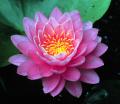| ||||||
|
Clarke County Georgia 33.955°N 83.383°W
| ||||||
|
| ||||||
|
Overview
Clarke County is in the heart of northeast Georgia's Piedmont region. It contains the cities of Athens and Winterville and is home to the main campus of the University of Georgia. With only 121 square miles, Clarke is the smallest county in Georgia. Its population of 127,000 live in a mix of urban to rural areas at an average density of over 1,000 inhabitants per square mile. Shoal Creek is one of two large creeks that drain eastern parts of the county into the Oconee River, which flows southwards into the Altamaha River and eventually the Atlantic. Since 2010 Discover Life has run a study site on Blue Heron Drive along Shoal Creek to document nightly changes in the long-term abundance and seasonality of insects and other creatures. To date we have taken over 300,000 photographs at this site's porch lights, documenting a healthy, rich diversity of over 1,320 species of moths and butterflies and numerous other species, including many beetles, aquatic insects, spiders, and frogs (see Overview and Results). Unlike other sites around the world that have recently reported alarming decreases in insect communities over the past few decades, the insect populations at our Blue Heron site have been relatively stable and not shown a general decline. It is notable that the Blue Heron property is exposed to almost no pesticides, whilst most of the sites reporting insect declines have probably been exposed to considerable amounts of chemical toxins. In 2019 Discover Life and the Oconee River Land Trust started developing the Shoal Creek Nature Sanctuary. This sanctuary will include our Blue Heron study site and surrounding properties along Shoal Creek, totaling over 400 acres in more that 30 properties if our vision comes to fruition. The core of the proposed sanctuary is the 224 acre Falling Shoals property, which is in a conservation easement in perpetuity and legally overseen by the land trust. Our key goal for the sanctuary is to improve human and environmental health, primarily through an educational campaign to reduce pesticide use in the creek's watershed. By also removing invasive species, planting native ones, reducing light pollution, and restoring a flood plain and other habitats in the sanctuary, we will protect piedmont biodiversity and species interactions within the plant-insect-vertebrate foodchain, thus protecting birds and other insectivores that are threatened by pesticides that can severely reduce their food supply. Through research, long-term monitoring, active land management, and community engagement, we will also improve pollination and other ecosystem services provided by the green space. The benefits will include better water quality in Shoal Creek and downstream, both from lower chemical runoff from the watershed and by re-engaging the floodplain to capture silt from the creek.
Contacts | ||||||
| Updated: 28 February, 2019 | ||||||
| Discover Life | Projects | Study sites | Top | ||||||
| © Designed by The Polistes Corporation | ||||||




